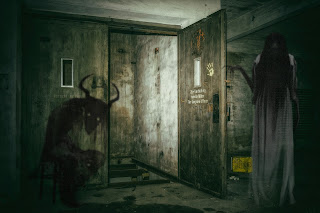Rolling Hills Asylum can date its history back to 1827 when it opened as the Gennessee County Poor House. A newspaper report from the time stated that it was open to: ‘“habitual drunkards, lunatics (one who by disease, grief, or accident lost the use of reason, or from old age, sickness, or weakness was so weak of mind as to be incapable of governing or managing their affairs), paupers (a person with no means of income), state paupers (one who is blind, lame, old, or disabled with no income source) or a vagrant.’
All inhabitants were
referred to as ‘inmates’, implying that whatever their reason for being there,
they were all the same and all, essentially, prisoners.
Rolling Hills has operated
variously as poor house, orphanage, asylum, and tuberculosis hospital. Around
1700 bodies are believed to be buried in the grounds – all in unmarked graves.
Its last function was as a nursing home, but it only lasted for ten years in
that guise mostly because of official code violations. It was then closed
permanently. Most of the dorms and old buildings were torn down at that point.
Now, it looks like
Hollywood’s ideal of a haunted asylum and hospital. The four storey brick
building needs little imagination to ‘see’ ghosts walking there. Its echoing
walls and corridors wreak of stories of inhumane treatment, despair and pain.
Set foot in this place and you know you are not alone. Walk – and the unquiet
spirits walk with you
And there have been plenty of reported incidents. Shadows, footsteps, ghostly touching, disembodied voices. It’s a ghosthunter’s delight. Not that all the ghosts are hostile.
Night-time ghost events are
run at the facility. One of the most frequently seen ghosts is believed to have
been Roy Crouse, who died in 1942. He spent most of his life here, was around
seven feet tall (it is believed as a result of gigantism) and his afterlife is
spent wandering as a very tall shadow who follows visitors, weeping. He may
have been captured on camera, as one female visitor on a tour said she heard
footsteps coming up behind her. Flashlights revealed no one there but then she
turned around and took a photo. Sure enough, if you look closely, there is a tall
shadow.
On the first floor of the
main building, is Hattie’s Room where an old woman has been recorded saying,
“Hello”. Roy’s room is also in this vicinity and he seems to have a soft spot
for ladies in distress. The current owner, Sharon Coyle, was terrified by a rat
in the infirmary about two months after moving in. She ran from there, screaming,
and the next day found the rat dead on the stairs with blood oozing from its
mouth as if its neck had been broken. On the wall above it, the clear mark of a
large, bloody handprint led her to believe Roy had done this for her. These
days, Roy is a much-loved figure of Rolling Hills. What would have been his 130th
birthday was celebrated in true style in April 2020.
On the second floor of the East Wing, shadow people move silently about in shades varying from pale grey to pitch black. The shadows creep along the floor or walk as humans. They can be amorphous shapes or human-like. Sometimes they appear as an appendage – an arm or a single leg.
In the basement, the Pysch Ward and Solitary
Confinement cells show evidence of shackles having been used to restrain those
deemed to be unruly. The Morgue, as might be expected, is a particularly
uncomfortable place to visit. An embalming table stands near two large walk-n
refrigerators for the storage of corpses. Visitors have heard ghostly voices
and seen things moved about by unseen forces. People have also been shoved and
even knocked off their feet here.
Outside, the exact location of the cemetery is
unknown. Nature has taken over and any gravestones have crumbled or become so
heavily overgrown as to be indistinguishable. No site map exists or even a
burial record.
For some, Rolling Hills will have been the only
home they ever knew.
Sharon Coyle has developed a thriving business
onsite – with ghost evenings, tours, shopping, dining and much more. Rolling
Hills is frequently used for filming and has been featured on a number of
television ghost hunting shows.
If you visit, don’t forget to say ‘Hi’, to Roy.
You’re next…
Carol and Nessa are strangers but not for much longer.
In a luxury apartment and in the walls of a modern hospital, the evil that was done continues to thrive. They are in the hands of an entity that knows no boundaries and crosses dimensions – bending and twisting time itself – and where danger waits in every shadow. The battle is on for their bodies and souls and the line between reality and nightmare is hard to define.
Through it all, the words of Lydia Warren Carmody haunt them. But who was she? And why have Carol and Nessa been chosen?
The answer lies deep in the darkness…
.





No, I won't be visiting. I'll leave the ghost tours to braver souls.:-) Besides, I prefer to read about fictional troubled ghosts rather than experience real ones!
ReplyDeleteThanks, Priscilla. Yes, I think you'd need to keep close to your companions on a tour to Rolling Hills. I wouldn't want to be on my own there - even with Roy for protection!
Delete